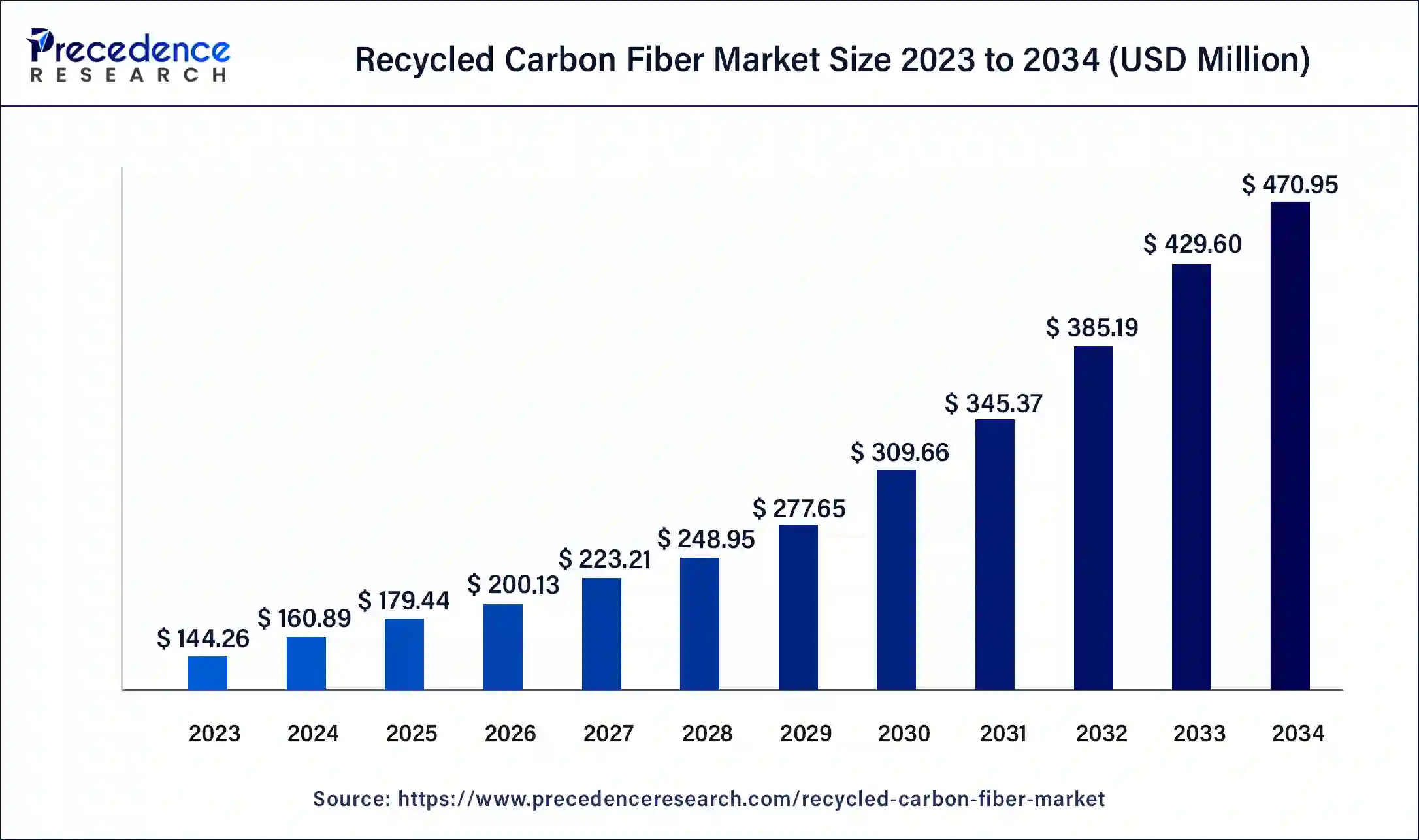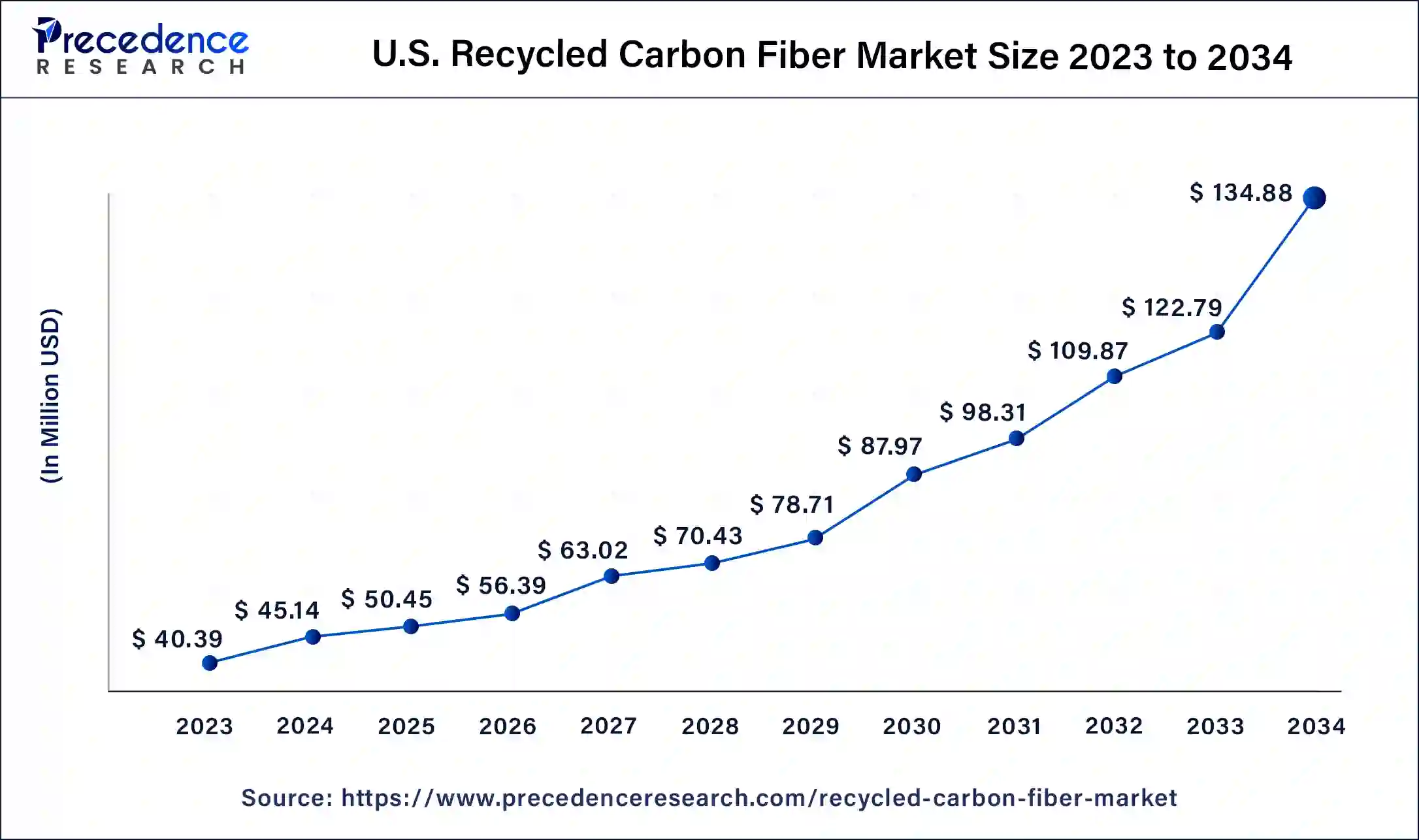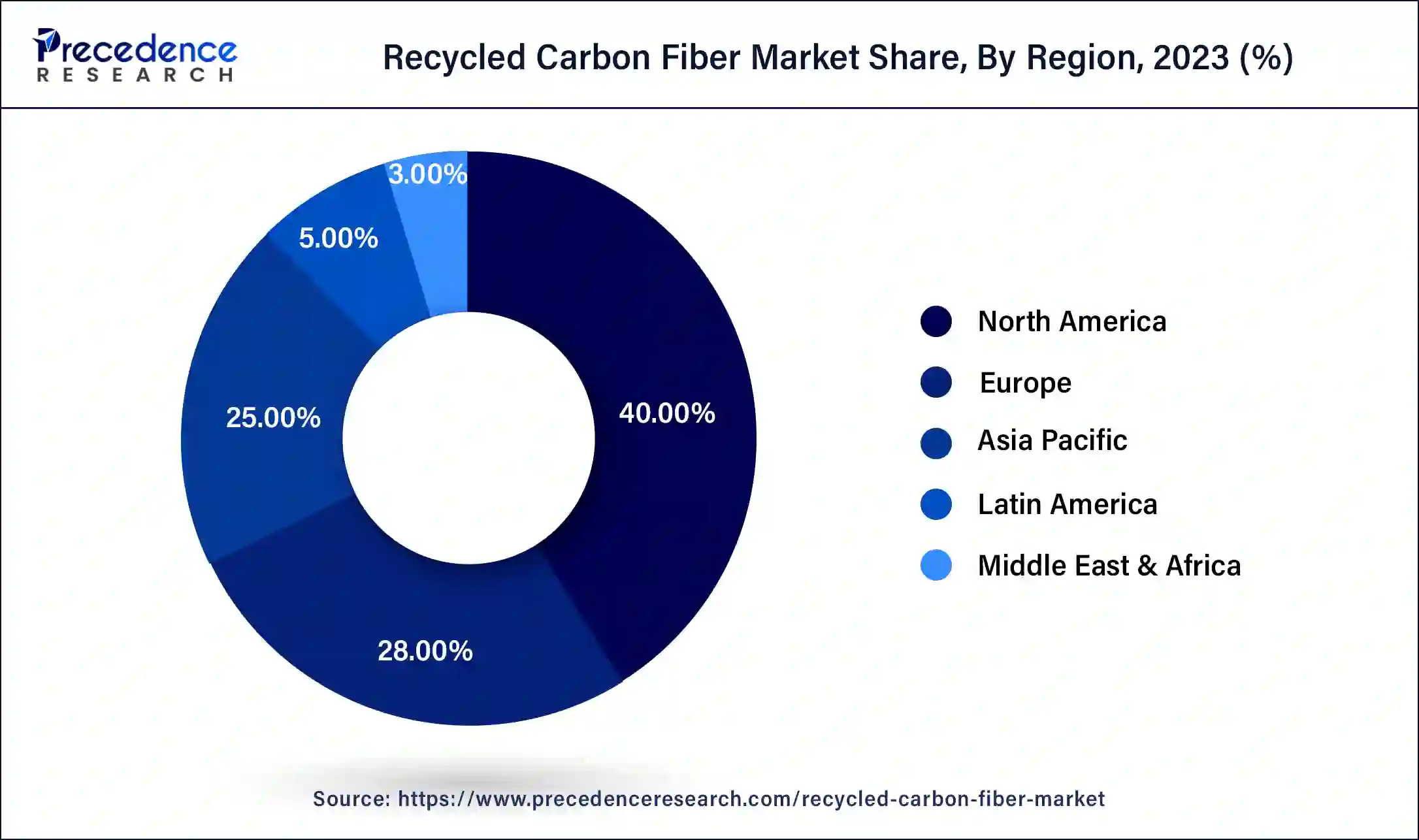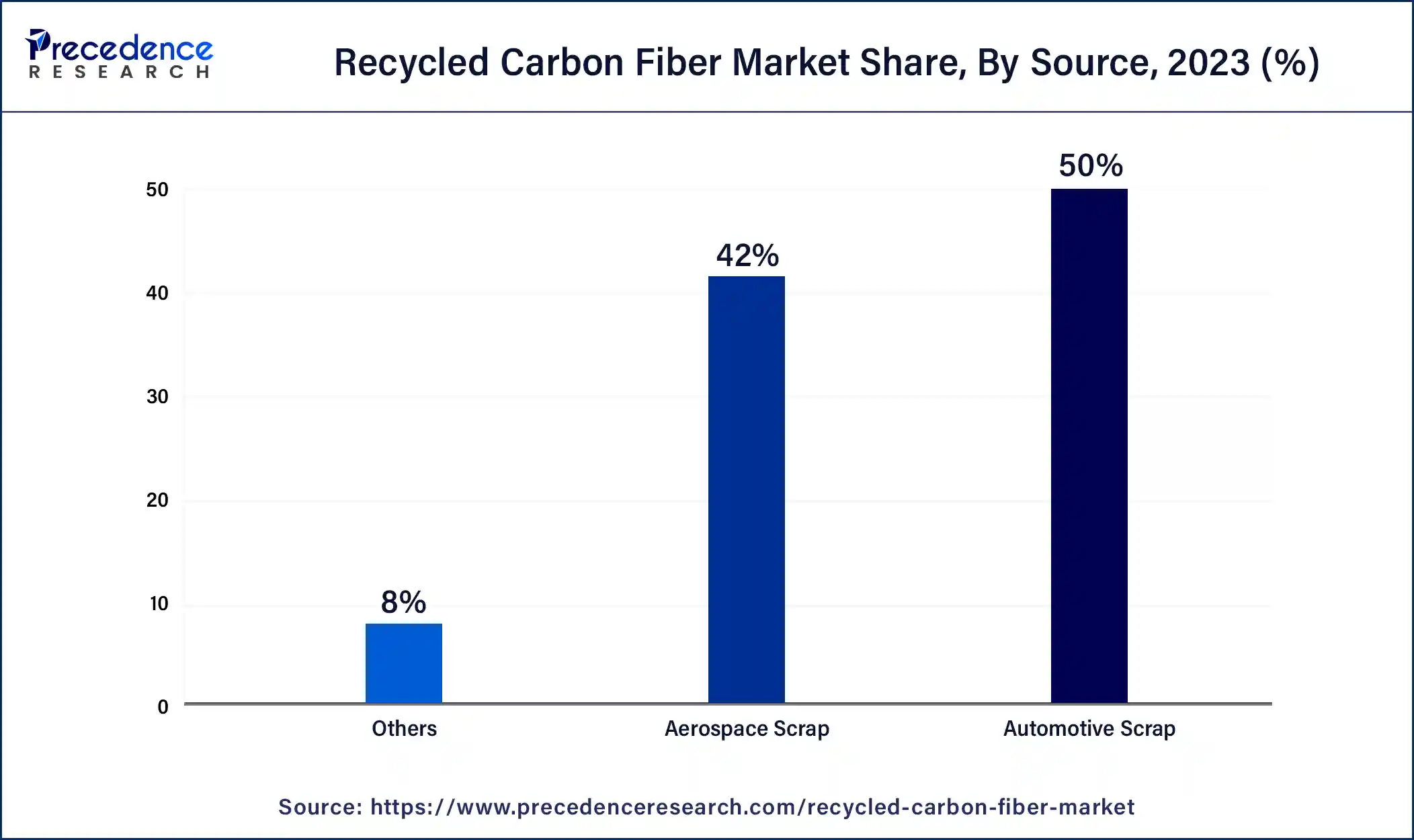May 2025
Recycled Carbon Fiber Market (By Product: Chopped Carbon Fiber, Milled Carbon Fiber, Carbon Fiber Mat, Others; By Source: Automotive Scrap, Aerospace Scrap, Others; By Recycling Method: Mechanical Recycling, Chemical Recycling, Pyrolysis, Solvolysis, Others; By End-use Industry: Aerospace and Defence, Automotive, Wind Energy, Sports and Leisure, Construction, Electronics, Others) - Global Industry Analysis, Size, Share, Growth, Trends, Regional Outlook, and Forecast 2024-2034
The global recycled carbon fiber market size is estimated at USD 160.89 million in 2024 and is anticipated to reach around USD 470.95 million by 2034, growing at a CAGR of 11.3% from 2024 to 2034. Recycled carbon fiber is in high demand because of increased carbon fiber use and the production of carbon fiber waste.

The U.S. recycled carbon fiber market size reached USD 40.39 million in 2023 and is expected to be worth around USD 134.88 million by 2034 at a CAGR of 11.57% from 2024 to 2034.

North America dominated the market in 2023. North American recycled carbon fiber market is the main source of sustainable materials that offer environmentally friendly solutions to industries to reduce carbon footprints. Rising use of recycled carbon fiber in automotive industries, the aerospace sector, applications for renewable energy, and construction helps to the growth of the market in this region. Automotive industries are in high demand for recycled carbon fiber in the North American region. The U.S. leads the automotive and aerospace sectors in the demand for recycled carbon fiber. In Canada, recycled carbon fiber is used in various sectors like planes, cars, industrial automation and robotics, sports equipment, medical equipment, and wind turbine blades, which helps the growth of the market.

Asia Pacific is estimated to be the fastest-growing during the forecast period of 2024-2034. The automotive and aerospace sectors of the Asia Pacific region have a high demand for recycled carbon fiber not only for economic and environmental reasons but also to increase their use in the aerospace, automotive, marine, and other sectors. These factors help to the growth of the market. Countries like China are the largest users of EVs, which use carbon fiber for building cars. China has a growing demand for recycled carbon fiber not only because the country needs it in various industries but also because the country is focusing on reducing carbon emissions, and the use of recycled carbon fiber can contribute to that.
Recycled carbon fiber is the new form of regenerated fiber that has properties like corrosion resistance, good electrical conductivity, high modulus, and high strength. The recycled carbon fiber market deals with the production and marketing of recycled carbon fiber products to various industries for their use, such as energy storage, pressure vessels, sporting goods, marine, civil engineering, aerospace, and automotive industries. The increasing use of carbon fibers and their compounds and the simultaneous rise in carbon fiber waste need the recycling of carbon fibers.
In different sectors, several studies have been conducted on recycled carbon fibers and their applications, including lithium-ion battery materials, thermoelectric materials, and electromagnetic shielding materials. The recycled carbon fiber properties also include compressive strength, tensile strength, flexural strength, fracture characteristics, electrical properties, workability, microstructural properties, impact resistance, and durability help the growth of the market.
| Report Coverage | Details |
| Growth Rate from 2024 to 2034 | CAGR of 11.3% |
| Global Market Size in 2023 | USD 144.26 Million |
| Global Market Size in 2024 | USD 160.89 Million |
| Global Market Size by 2034 | USD 470.95 Million |
| Largest Market | North America |
| Base Year | 2023 |
| Forecast Period | 2024 to 2034 |
| Segments Covered | Product, Source, Recycling Method, End-use Industry, and Region |
| Regions Covered | North America, Europe, Asia-Pacific, Latin America, and Middle East & Africa |
Environmental sustainability
There is a need for recycled carbon fiber for the recyclability and environmental sustainability of the materials, which will help the continuous growth of the recycled carbon fiber market. Increased importance on the reduction of carbon emissions implemented by the European Union and the United States Environmental Protection Agency. Recycled carbon fiber provides reasonable and eco-friendly or environmentally friendly replacements for raw carbon fiber. There is also a demand for eco-friendly and recyclable materials for environmental sustainability.
Cost and security of supply
For cost reduction, recycled carbon fibers are highly used. For raw carbon fiber, recycled carbon fiber is a good alternative. Manufacturers can save production costs by the use of waste materials. The carbon fiber industry faces the problem of the supply and demand of carbon fibers. The recycling of carbon fibers can overcome this issue. This helps to the growth of the recycled carbon fiber market.
Challenges in carbon fiber recycling
Most of the product materials are not made from recycled carbon fibers or disposable materials because it is tough to find sufficient carbon fibers for recycling. Carbon fibers are not as strong as specific metals. Due to its brittleness, sudden or sharp impacts can shatter or crack. Carbon fiber costs more than aluminum, steel, or other options. Recycling carbon fiber is challenging because of its complex nature which makes it less environmentally friendly and sustainable than the other materials which are easy to use. There is a risk of shock because carbon fiber conducts electricity when it is not operated correctly and also if it is used in electrical applications. These factors may restrict the growth of the recycled carbon fiber market.
Utilization of recycled carbon fibers in thermoplastics
Increasing the use of recycled carbon fibers in thermoplastics can create highly specific stiffness materials and low-cost materials for various applications. This can be an opportunity because of their recycling availability and easy processibility. The demand for surface treatments can increase to improve surface functional groups and adhesion between polymer material and carbon fibers. This helps to the growth of the recycled carbon fiber market.
The chopped carbon fiber segment dominated the market in 2023. Recycled chopped carbon fiber provides sustainability and cost-saving advantages. The recycled chopped carbon fiber properties include low thermal expansion, dimensional stability, low density, high modulus, and high strength, which contribute to the growth of the segment. The recycled chopped carbon fiber is thermally and electrically conductive, making it perfect for high-temperature thermoplastic resins and general engineering thermoplastics. These factors help the growth of the segment and contribute to the growth of the recycled carbon fiber market.
The milled carbon fiber segment is the fastest growing during the forecast period. Milled carbon fiber is a strengthened material that is made up of glass fiber or chopped carbon with a length of less than 1mm. It is normally used to improve the mechanical features of compound materials. Recycled milled fibers are helpful in cost-saving, waste reduction, and sustainability for aerospace industrial applications. These milled carbon fibers also have other benefits, like material multifunctionality, electrical conductivity, sensor technology, and structural support. Recycled milled carbon fibers can be used to improve the strength of the recycled carbon fibers that are made of waste carbon fiber for new applications, which contribute to the growth of the segment.
The automotive scrap segment dominated the recycled carbon fiber market in 2023. Automobile products/goods are recycled by most nations. Automobile scraps include a lot of heterogeneous materials, and due to this, there is a high use of recycled carbon fiber for these materials to achieve environmental sustainability. These factors help to the growth of the market. The automotive industry is continuously growing, and the use of carbon fiber in EVs is growing. Carbon fiber is light weight which makes the EVs more efficient and suitable for battery usage.

The aerospace scrap segment is the fastest growing during the forecast period. Recycling and reuse of carbon fiber is due to it has high value, usable components, and does not require destructive separation. Carbon fiber stays in its original state, either in woven fabric or unidirectional tape. Composite materials such as carbon materials are largely used in the aerospace industry. For the reduction of solid waste, recycling carbon fiber has the main role. In this sector, recycled carbon fibers are used to replace titanium and aluminum alloys. These factors help in the growth of the segment and contribute to the growth of the recycled carbon fiber market.
The mechanical recycling segment dominated the recycled carbon fiber market in 2023. Mechanical recycling mostly depends on shredding, milling, grinding, and crushing of compound parts into compact pieces that may again be powdered. After this, powdered product sieving is normally carried out to obtain resin-rich and fiber-rich products. The mechanical recycling method of carbon fiber has a recovery ratio that is higher than that of traditional thermolysis and two-step microwave methods. The epoxy resin of the carbon fiber decays first, and the char oxidization occurs in the second step. This method is used for virgin polymer production and helps reduce greenhouse gases, plastic pollution, and waste. These factors help the segment grow.
The chemical recycling segment is the fastest-growing segment during the forecast period. The chemical recycling method for carbon fiber includes microwave-assisted thermolysis (MAT) and two-step pyrolysis (TSP). Two-step pyrolysis restricts fiber damage and conserves original mechanical characteristics. Metal-assisted thermolysis gives -CH,-CO, and -OH functional groups and surface activation. The chemical recycling method helps reduce landfill waste by using carbon fiber materials. It also helps conserve natural resources due to the use of waste carbon fiber materials without the production of new resources. Chemical recycling also includes solvolysis, gasification, and pyrolysis. These factors contribute to the growth of the segment and the growth of the market.
The aerospace and defense segment dominated the market. In aerospace and defense, there is a high use of carbon-fiber-reinforced plastics, which results in a large amount of waste, and there is a need to reuse recycled carbon fiber to reduce waste landfills. For many industries' sustainable development, carbon fiber recycling is the main factor. Due to their high strength and lightweight properties, they are used in the aerospace and defense sector for satellites, wings, spacecraft parts, and aircraft. In the aerospace sector, recycled carbon fibers are used to replace alloys, titanium, and aluminum. In the defense sector, recycled carbon fibers are used in protective equipment, building supplies, musical instruments, canoes, watches, hard hats, knives, drones, and other weapons. These factors help the growth of the segment and contribute to the growth of the recycled carbon fiber market.
Segments Covered in the Report
By Product
By Source
By Recycling Method
By End-use Industry
By Geography
For inquiries regarding discounts, bulk purchases, or customization requests, please contact us at sales@precedenceresearch.com
No cookie-cutter, only authentic analysis – take the 1st step to become a Precedence Research client
May 2025
June 2025
May 2025
December 2024